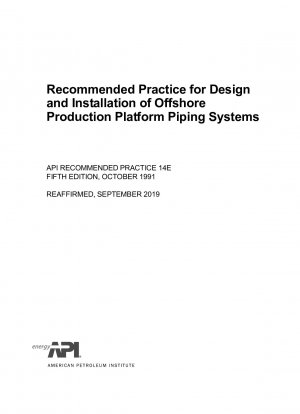API RP 14E-1991(2019)
RECOMMENDED PRACTICE FOR DESIGN AND INSTALLATION OF OFFSHORE PRODUCTION PLATFORM PIPING SYSTEMS FOURTH EDITION
- Standard No.
- API RP 14E-1991(2019)
- Release Date
- 1991
- Published By
- API - American Petroleum Institute
- Scope
- This document recommends minimum requirements and guidelines for the design and installation of new piping systems on production platforms located offshore. The maximum design pressure within the scope of this document is 10@000 psig and the temperature range is -20??to 650?? For applications outside these pressures and temperatures@ special consideration should be given to material properties (ductility@ carbon migration@ etc.). The recommended practices presented are based on years of experience in developing oil and gas leases. Practically all of the offshore experience has been in hydrocarbon service free of hydrogen sulfide. However@ recommendations based on extensive experience onshore are included for some aspects of hydrocarbon service containing hydrogen sulfide. a. This document contains both general and specific information on surface facility piping systems not specified in API Specification 6A. Sections 2@ 3 and 4 contain general information concerning the design and application of pipe@ valves@ and fittings for typical processes. Sections 6 and 7 contain general information concerning installation@ quality control@ and items related to piping systems@ e.g.@ insulation@ etc. for typical processes. Section 5 contains specific information concerning the design of particular piping systems including any deviations from the recommendations covered in the general sections. b. Carbon steel materials are suitable for the majority of the piping systems on production platforms. At least one carbon steel material recommendation is included for most applications. Other materials that may be suitable for platform piping systems have not been included because they are not generally used. The following should be considered when selecting materials other than those detailed in this RP. (1) Type of service. (2) Compatibility with other materials. (3) Ductility. (4) Need for special welding procedures. (5) Need for special inspection@ tests@ or quality control. (6) Possible misapplication in the field. (7) Corrosion/erosion caused by internal fluids and/or marine environments.
